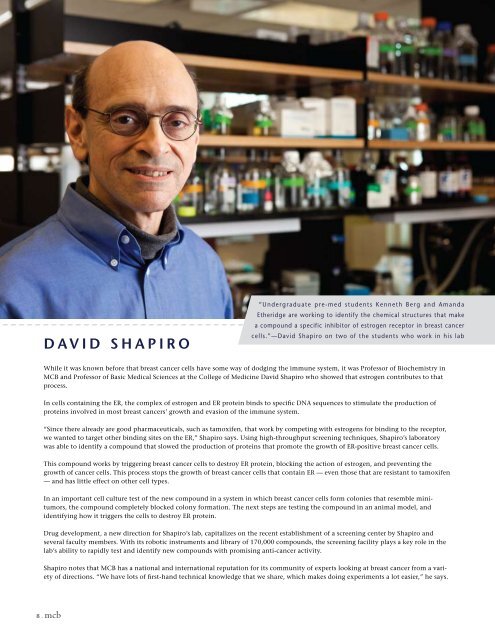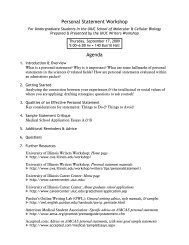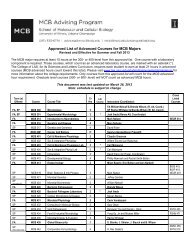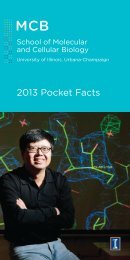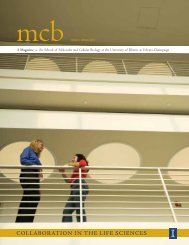breast cancer research • mcb as pre-med - The School of Molecular ...
breast cancer research • mcb as pre-med - The School of Molecular ...
breast cancer research • mcb as pre-med - The School of Molecular ...
You also want an ePaper? Increase the reach of your titles
YUMPU automatically turns print PDFs into web optimized ePapers that Google loves.
daVId shaPIro<br />
While it w<strong>as</strong> known before that <strong>bre<strong>as</strong>t</strong> <strong>cancer</strong> cells have some way <strong>of</strong> dodging the immune system, it w<strong>as</strong> Pr<strong>of</strong>essor <strong>of</strong> Biochemistry in<br />
MCB and Pr<strong>of</strong>essor <strong>of</strong> B<strong>as</strong>ic Medical Sciences at the College <strong>of</strong> Medicine David Shapiro who showed that estrogen contributes to that<br />
process.<br />
In cells containing the ER, the complex <strong>of</strong> estrogen and ER protein binds to specific DNA sequences to stimulate the production <strong>of</strong><br />
proteins involved in most <strong>bre<strong>as</strong>t</strong> <strong>cancer</strong>s’ growth and ev<strong>as</strong>ion <strong>of</strong> the immune system.<br />
“Since there already are good pharmaceuticals, such <strong>as</strong> tamoxifen, that work by competing with estrogens for binding to the receptor,<br />
we wanted to target other binding sites on the ER,” Shapiro says. Using high-throughput screening techniques, Shapiro’s laboratory<br />
w<strong>as</strong> able to identify a compound that slowed the production <strong>of</strong> proteins that promote the growth <strong>of</strong> ER-positive <strong>bre<strong>as</strong>t</strong> <strong>cancer</strong> cells.<br />
This compound works by triggering <strong>bre<strong>as</strong>t</strong> <strong>cancer</strong> cells to destroy ER protein, blocking the action <strong>of</strong> estrogen, and <strong>pre</strong>venting the<br />
growth <strong>of</strong> <strong>cancer</strong> cells. This process stops the growth <strong>of</strong> <strong>bre<strong>as</strong>t</strong> <strong>cancer</strong> cells that contain ER — even those that are resistant to tamoxifen<br />
— and h<strong>as</strong> little effect on other cell types.<br />
In an important cell culture test <strong>of</strong> the new compound in a system in which <strong>bre<strong>as</strong>t</strong> <strong>cancer</strong> cells form colonies that resemble minitumors,<br />
the compound completely blocked colony formation. <strong>The</strong> next steps are testing the compound in an animal model, and<br />
identifying how it triggers the cells to destroy ER protein.<br />
Drug development, a new direction for Shapiro’s lab, capitalizes on the recent establishment <strong>of</strong> a screening center by Shapiro and<br />
several faculty members. With its robotic instruments and library <strong>of</strong> 170,000 compounds, the screening facility plays a key role in the<br />
lab’s ability to rapidly test and identify new compounds with promising anti-<strong>cancer</strong> activity.<br />
Shapiro notes that MCB h<strong>as</strong> a national and international reputation for its community <strong>of</strong> experts looking at <strong>bre<strong>as</strong>t</strong> <strong>cancer</strong> from a variety<br />
<strong>of</strong> directions. “We have lots <strong>of</strong> first-hand technical knowledge that we share, which makes doing experiments a lot e<strong>as</strong>ier,” he says.<br />
8 . <strong>mcb</strong><br />
“Undergraduate <strong>pre</strong>-<strong>med</strong> students Kenneth Berg and Amanda<br />
Etheridge are working to identify the chemical structures that make<br />
a compound a specific inhibitor <strong>of</strong> estrogen receptor in <strong>bre<strong>as</strong>t</strong> <strong>cancer</strong><br />
cells.”—David Shapiro on two <strong>of</strong> the students who work in his lab


